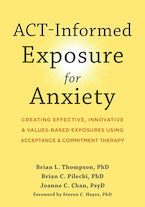By Brian L. Thompson, PhD, coauthor of ACT-Informed Exposure for Anxiety
Safety behaviors are behaviors people engage in to prevent or minimize either something bad happening or to manage their own distress. They tend to contribute to the maintenance of anxiety-related issues. What makes a “safety behavior” a safety behavior is that these behaviors are likely to have minimal impact on a feared outcome. Obsessive-compulsive disorder (OCD) is a classic example: someone with OCD may engage in rituals to ward of catastrophic things from happening even though these actions are unlikely to have much effect, and, if anything, tend to cause more anxiety. Having to have your phone on you whenever you leave the house in case something bad happens is an example of a common safety behavior.
Safety behaviors can be very powerful. One client I worked with felt the need to carry an inhaler on his person whenever he went jogging because he feared having an asthma attack—even though his doctor had assured him he was not asthmatic. I suggested he try running without it. At the next session, the client observed that during the first few days of running without his inhaler, he felt extremely anxious. However, he quickly got used to it, and within a week, no longer thought about it.
Because reliance on safety behaviors can maintain anxiety, it’s long been assumed that safety behaviors must be eliminated in the treatment of anxiety disorders through exposure therapy, where people learn to systematically confront their anxiety and do things they have been avoiding.
But are safety behaviors always a problem? Blakey and Abramowitz (2016) ask this question in a literature of research on safety behaviors.
Research to date has been mixed on this question, as some studies have found safety behaviors interfere with exposure therapy, and some have found they don’t. Additionally, thoughtful use of safety behaviors may help people engage in exposure they would not be willing to do otherwise.
From their review, the researchers concluded that, while safety behaviors aren’t “unconditionally deleterious,” they tend to get in the way of exposure therapy more often than not. The authors recommend that once identified, therapists should work with anxiety clients to eliminate their reliance on safety behaviors as soon as clients are willing. “Willing” is a key word here, as clients may be reluctant to give them up.
For example, some people with fears around driving are more comfortable if they have a passenger who can take over if the driver becomes overwhelmed with panic. Therefore, they may be more comfortable driving new routes with a trusted passenger than alone. Some clients may even initially refuse to drive new routes without a loved one accompanying them. However, this safety behavior can get in the way of making progress if the client cannot drive any new route by themselves. In these ways, the same safety behaviors that may help facilitate client progress in exposure can become a barrier to completing treatment if the client isn’t willing to eventually give up certain avoidance behaviors.
In my recent book on acceptance and commitment therapy (ACT)-informed exposure, I wrote:
A metaphor one of us uses with clients is rivulets feeding an anxiety river. The more rivulets that feed the anxiety river, the stronger it flows. Although we may not be able to block every single rivulet, we want to disrupt as many as we can to weaken the flow of the river as much as possible. Every avoidance behavior is a potential rivulet. Even if some appear small and inconsequential, they nonetheless reinforce anxiety and psychological inflexibility, and they should be disrupted as much as possible.
In working with people on anxiety, we want to eventually wean people off reliance on safety behaviors, so that they’re able to engage their lives with greater freedom and flexibility.
Brian L. Thompson, PhD, is a licensed psychologist; and director of the anxiety clinic at the Portland Psychotherapy in Portland, OR. He specializes in working with anxiety and obsessive-compulsive and related disorders, and has published research in these areas.



 2024 Peace Playbook: 3 Tactics to Avoid Clashes with Your Partner
2024 Peace Playbook: 3 Tactics to Avoid Clashes with Your Partner